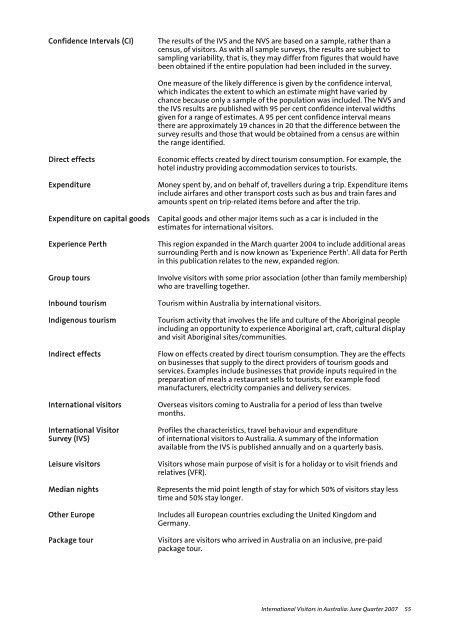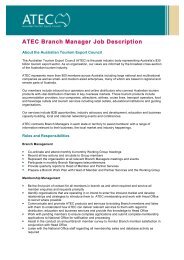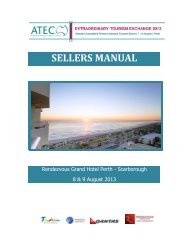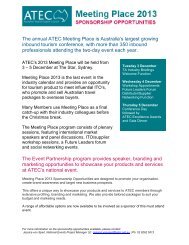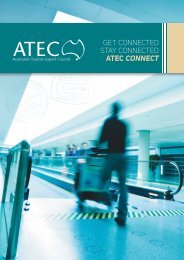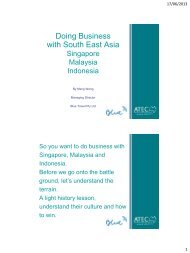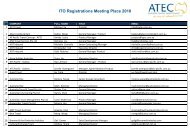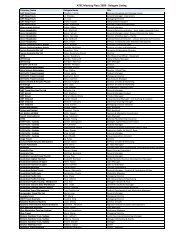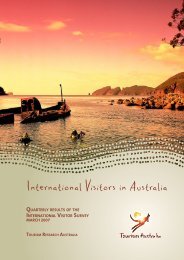Contents - ATEC Australian Tourism Export Council
Contents - ATEC Australian Tourism Export Council
Contents - ATEC Australian Tourism Export Council
Create successful ePaper yourself
Turn your PDF publications into a flip-book with our unique Google optimized e-Paper software.
Confidence Intervals (CI) The results of the IVS and the NVS are based on a sample, rather than a<br />
census, of visitors. As with all sample surveys, the results are subject to<br />
sampling variability, that is, they may differ from figures that would have<br />
been obtained if the entire population had been included in the survey.<br />
One measure of the likely difference is given by the confidence interval,<br />
which indicates the extent to which an estimate might have varied by<br />
chance because only a sample of the population was included. The NVS and<br />
the IVS results are published with 95 per cent confidence interval widths<br />
given for a range of estimates. A 95 per cent confidence interval means<br />
there are approximately 19 chances in 20 that the difference between the<br />
survey results and those that would be obtained from a census are within<br />
the range identified.<br />
Direct effects Economic effects created by direct tourism consumption. For example, the<br />
hotel industry providing accommodation services to tourists.<br />
Expenditure Money spent by, and on behalf of, travellers during a trip. Expenditure items<br />
include airfares and other transport costs such as bus and train fares and<br />
amounts spent on trip-related items before and after the trip.<br />
Expenditure on capital goods Capital goods and other major items such as a car is included in the<br />
estimates for international visitors.<br />
Experience Perth This region expanded in the March quarter 2004 to include additional areas<br />
surrounding Perth and is now known as 'Experience Perth'. All data for Perth<br />
in this publication relates to the new, expanded region.<br />
Group tours Involve visitors with some prior association (other than family membership)<br />
who are travelling together.<br />
Inbound tourism <strong>Tourism</strong> within Australia by international visitors.<br />
Indigenous tourism <strong>Tourism</strong> activity that involves the life and culture of the Aboriginal people<br />
including an opportunity to experience Aboriginal art, craft, cultural display<br />
and visit Aboriginal sites/communities.<br />
Indirect effects Flow on effects created by direct tourism consumption. They are the effects<br />
on businesses that supply to the direct providers of tourism goods and<br />
services. Examples include businesses that provide inputs required in the<br />
preparation of meals a restaurant sells to tourists, for example food<br />
manufacturers, electricity companies and delivery services.<br />
International visitors Overseas visitors coming to Australia for a period of less than twelve<br />
months.<br />
International Visitor Profiles the characteristics, travel behaviour and expenditure<br />
Survey (IVS) of international visitors to Australia. A summary of the information<br />
available from the IVS is published annually and on a quarterly basis.<br />
Leisure visitors Visitors whose main purpose of visit is for a holiday or to visit friends and<br />
relatives (VFR).<br />
Median nights Represents the mid point length of stay for which 50% of visitors stay less<br />
time and 50% stay longer.<br />
Other Europe Includes all European countries excluding the United Kingdom and<br />
Germany.<br />
Package tour Visitors are visitors who arrived in Australia on an inclusive, pre-paid<br />
package tour.<br />
International Visitors in Australia: June Quarter 2007 55


